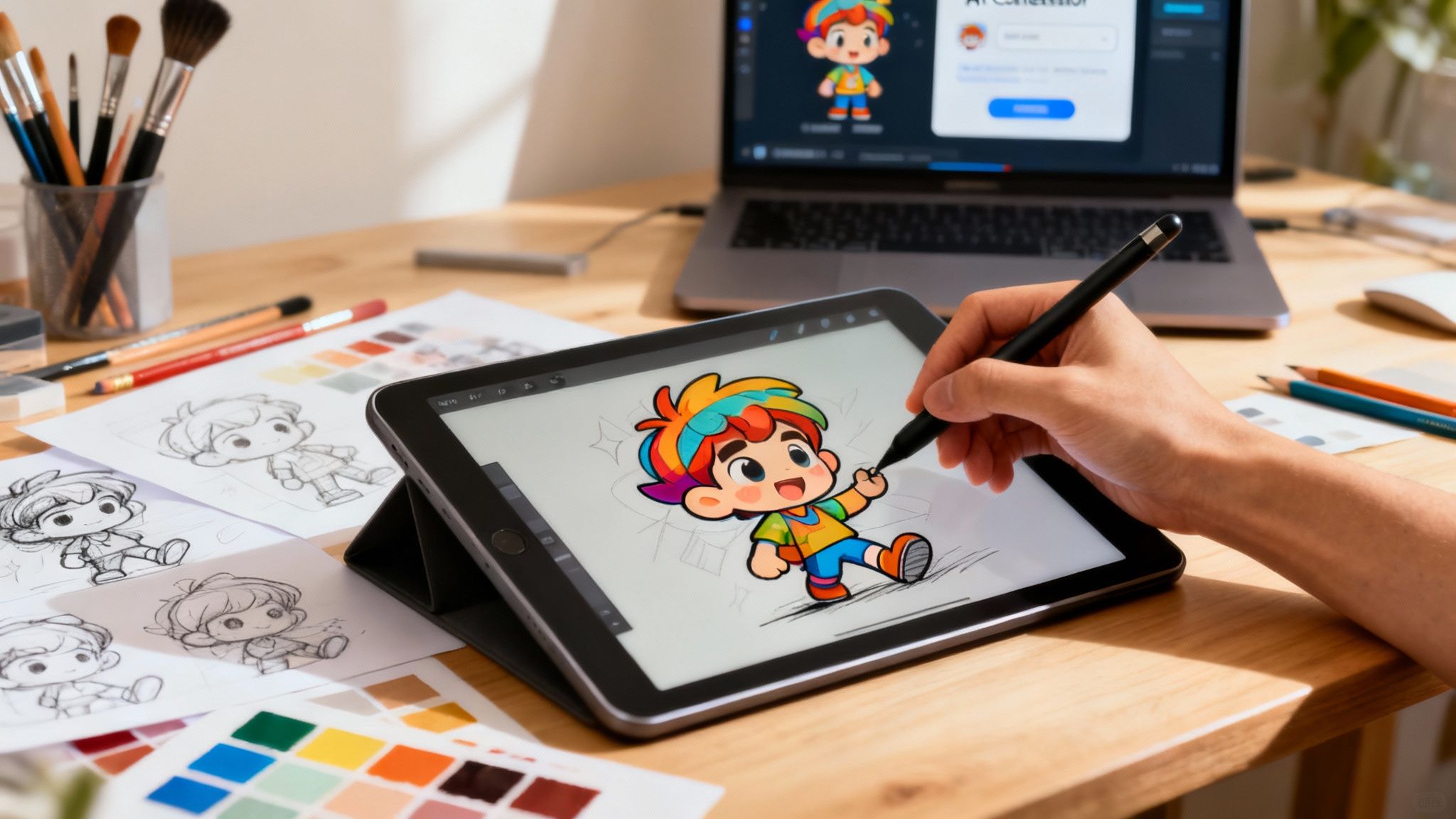
Meta Description: Discover how AI style transfer technology works. Learn how creators and marketers can use AI to transform photos into unique art for campaigns and content.
Have you ever seen a photo and sworn it was painted by a master like Van Gogh or Monet? That’s the magic of AI style transfer, a game-changing technology for creators and marketers. It teaches a computer to see the world through an artist’s eyes and repaint your images in their iconic style. But this isn't just a simple filter; it's a sophisticated creative reinterpretation. The challenge for many is creating fresh, eye-catching visuals without breaking the bank or spending hours in design software. This guide will show you how AI style transfer provides a powerful solution, making bespoke art accessible to everyone.
What Is AI Style Transfer?
At its core, AI style transfer is a computer vision technique that uses deep learning to blend two images: a content image (the subject) and a style image (the artistic look). The AI model intelligently separates the foundational structure of your photo from the unique textures and color patterns of an art piece, then masterfully combines them. This creates a brand-new visual that has the composition of your photo but is rendered with the artistic DNA of another. This makes it an incredibly powerful tool for marketers, content creators, and agencies looking to produce unique visuals efficiently.
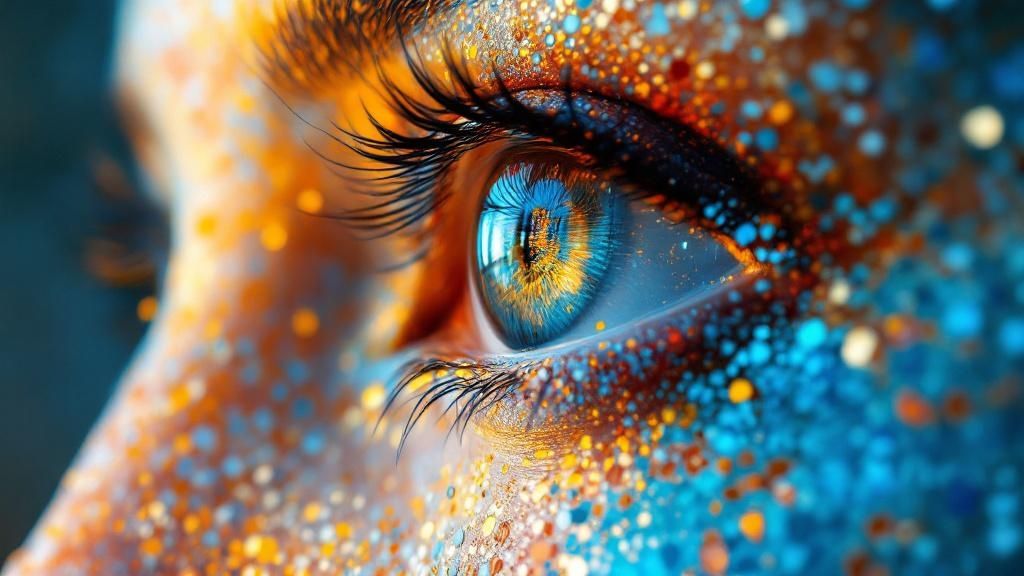
The Three Key Ingredients
To understand how AI style transfer works, you need to know the three core elements involved. Each plays a critical role in shaping the final artwork.
- Content Image: This is your starting point—the photo or subject you want to transform. It provides the fundamental structure, defining the objects, shapes, and overall layout of the final image.
- Style Image: This is where the artistic DNA comes from. The AI analyzes this image to extract its textures, color palette, and distinctive patterns, which it will then apply to your content image.
- Generated Image: This is the final output. It’s a brand-new visual that has the structure and composition of your content image but is rendered in the artistic style of the style image.
This fusion of content and style is what truly sets AI style transfer apart from basic photo filters, which just lay a simple color effect over an image. This technique is part of a larger suite of powerful https://mediaworkbench.ai/blog/ai-content-creation-tools that are changing how we create visuals.
Core Components of AI Style Transfer
This table sums up the three essential images that come together to create a new piece of stylized art, a helpful comparison for any marketer or creator.
| Component | Role | Real-World Use Case |
|---|---|---|
| Content Image | Provides the structure and subject matter. | A photo of a new product for an ad campaign. |
| Style Image | Provides the artistic texture, color, and patterns. | A brand's abstract pattern or a public domain painting. |
| Generated Image | The final result, a new piece of art. | The product photo, reimagined in a unique, on-brand artistic style for social media. |
Once you grasp these three roles, you’ve unlocked the basic principle behind one of AI’s most creative applications for digital marketing and content creation.
The Evolution of Digital Artistry
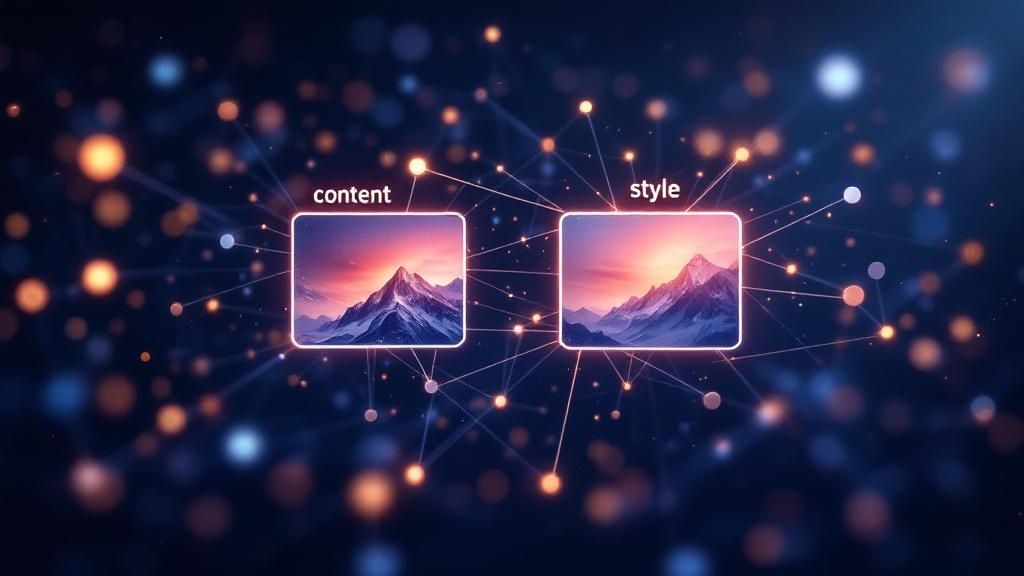
The ability to perform AI style transfer didn't just appear overnight. It’s a technology built on decades of breakthroughs in computer science. The journey from a niche academic idea to an accessible tool for content creators and marketers is a story of key moments that captured our imagination and propelled the tech forward. Before sophisticated AI, digital art was a painstaking craft. Artists relied on software to paint pixel by pixel, demanding immense skill and time. The idea that a machine could learn an artistic style felt like pure science fiction.
From Academic Papers to Public Fascination
The game changed when researchers pointed deep neural networks at images. These models, originally built for object recognition, turned out to be surprisingly good at understanding the building blocks of artistic style. The turning point was 2015 with Google’s DeepDream, which produced surreal, dreamlike visuals that went viral. This was the public's first glimpse of AI’s creative potential. DeepDream's psychedelic outputs laid the groundwork for the more refined AI style transfer methods that followed. By 2018, NVIDIA’s StyleGAN could generate incredibly realistic images, transforming AI art into a serious tool for professionals. You can get a more detailed look at these breakthroughs by exploring the history of AI art on AI Art Kingdom.
Maturing into a Professional Creative Asset
As the technology matured, so did its uses. What started as a fun way to make selfies look like paintings quickly became a serious asset for creative professionals. The core shift was from imitation to collaboration, as new models allowed creators to blend styles and guide the AI.
- For Agencies: Concept artists could now generate dozens of stylistic takes on a campaign visual in minutes, not days.
- For Marketers: Brands could create unique, on-brand imagery for social media without a huge illustration budget.
- For Creators: Filmmakers began to experiment with applying artistic styles to video, transforming entire scenes frame by frame.
Today, AI style transfer is baked into many content creation platforms, including the versatile tools offered by MediaWorkbench.ai. It has become a core part of the modern creator’s toolkit, proving that a once-experimental technology can become an indispensable professional resource.
👉 Try MediaWorkbench.ai for free – schedule your posts and generate AI content in one place!
How AI Style Transfer Actually Works
At first glance, AI style transfer feels like magic. You feed an AI two images, and out comes a brand-new, artistic creation. But what's really going on under the hood? This isn't a simple photo filter—it's a sophisticated process that hinges on how AI learns to "see" and interpret visual data. Think of the AI model as a world-class art historian who can look at any painting and instantly deconstruct its two most fundamental parts: the content (what the painting is of) and the style (how it was painted). AI style transfer models do something remarkably similar.
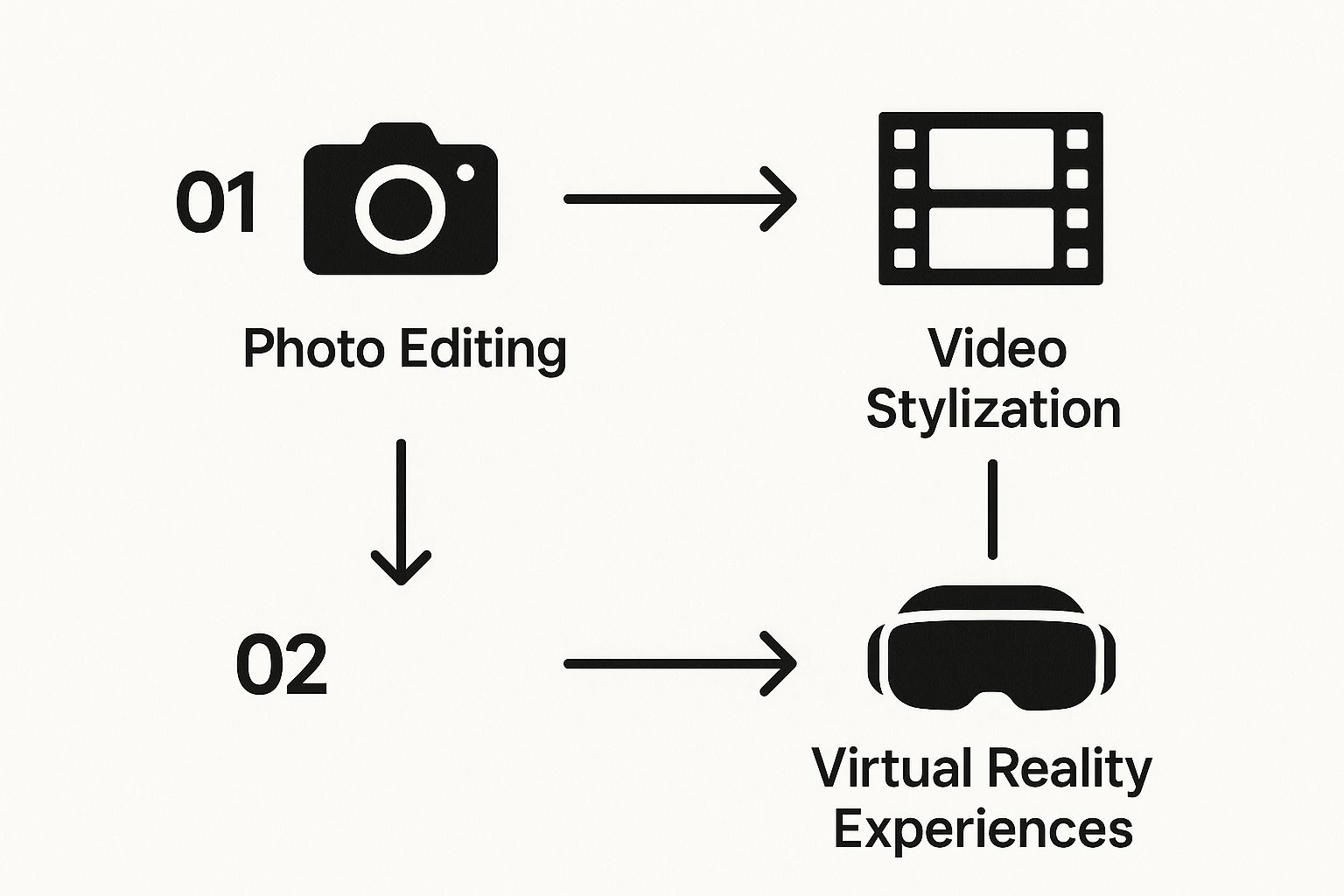
The Brains of the Operation: Convolutional Neural Networks (CNNs)
The core technology is the Convolutional Neural Network (CNN). Originally built for image recognition, CNNs process images in layers. The first layers spot basic elements like edges and colors, while deeper layers recognize complex shapes. AI style transfer cleverly hijacks this layered understanding:
- Content Analysis: The model runs the content image through the CNN, focusing on deeper layers to grasp the scene's structure. This creates a "content representation."
- Style Analysis: It then examines the style image, paying attention to textures and color patterns in the earlier layers to build a "style representation."
Finally, the AI starts with a blank slate and begins to "paint," constantly adjusting the new image to match the content of the first image and the style of the second.
The Next Level: Generative Adversarial Networks (GANs)
While CNNs laid the foundation, Generative Adversarial Networks (GANs) have taken style transfer to a new level. A GAN is a two-part system:
- The Generator: This network is the "artist," creating new images that try to mimic the target style.
- The Discriminator: This one is the "art critic," examining the Generator's work and trying to spot fakes.
This "adversarial" training forces the Generator to produce images that are not just stylized but also coherent and believable, a technique that has fueled the growth of AI applications worldwide. You can discover more insights about this deep learning evolution at OUP.
Popular AI Style Transfer Tools and Platforms
Now that you understand the concepts, you’re probably ready to start creating. The world of AI style transfer is packed with tools for every need—from quick mobile edits for a freelancer to high-resolution masterpieces for an agency. The game changed around 2022 when platforms like Midjourney made the technology accessible to millions. Before then, it required serious technical skill. Now, creators can generate incredible art from a simple chat prompt. You can get a feel for this rapid evolution on Sii.pl.
Choosing the Right Tool for the Job
Which tool is right for you? It boils down to your project's needs. A social media manager creating daily content has different requirements than a designer building a brand campaign. Here's a comparison of popular tools:
| Tool | Best For | Key Features | Pricing Model |
|---|---|---|---|
| Midjourney | Artists & Designers | High-quality output, style reference commands (--sref), vast community support via Discord. |
Subscription-based |
| Prisma | Social Media Creators | Quick, one-tap mobile editing with a large library of artistic filters. | Freemium (Free with limited styles, premium subscription for full access) |
| DeepArt.io | Hobbyists & Experimenters | Custom style and content image uploads, straightforward web interface. | Pay-per-image (or subscription for faster processing) |
| Stable Diffusion | Developers & Tech-Savvy Users | Open-source, highly customizable models, runs locally for full control. | Free (requires local setup) or via paid cloud platforms |
Start with a free or freemium tool to experiment with different styles before committing to a paid plan. For more options, check out our guide on the top 10 AI tools for content creators in 2025.
Real-World Applications For Creators And Marketers
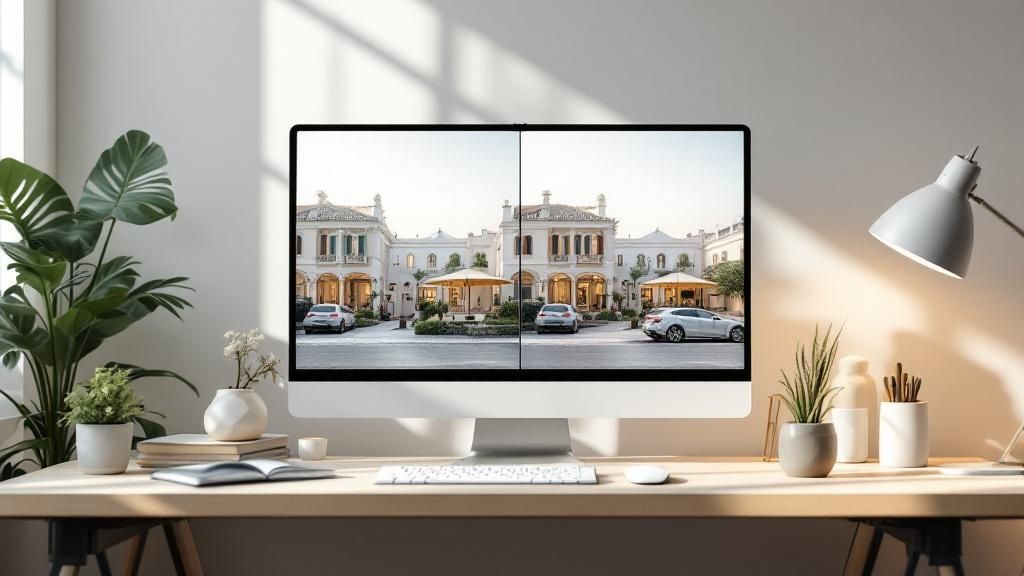
Understanding the tech behind AI style transfer is one thing, but seeing it deliver real-world results is where it gets exciting. For marketers and creators, this isn't just a gimmick. It’s a practical tool that can save hours, elevate a brand’s visual identity, and capture an audience's attention. Forget relying on the same old stock photos. With style transfer, brands can generate an endless stream of unique, on-brand images, bridging the gap between a standard photograph and a bespoke piece of art without a hefty budget.
Transforming Marketing and Advertising Visuals
In a crowded digital space, stopping the scroll is the biggest challenge. AI style transfer gives marketers a secret weapon to create ad visuals and social media content that are impossible to ignore. A brand can use AI to repaint product shots in a lush, watercolor style that reinforces a natural, fresh identity.
- Social Media Campaigns: Generate a month's worth of visually consistent posts for Instagram, where a strong aesthetic is everything.
- Ad Creatives: A/B test different artistic styles on ad banners to see what resonates with your audience and boosts click-through rates.
- Email Marketing: Use a unique, stylized hero image in your newsletter to grab subscribers' attention instantly.
This strategy lets marketers infuse campaigns with a distinct artistic mood, building an emotional connection that is often more powerful than traditional branding. Discover other AI tools for content marketing to build a powerful visual strategy.
Mini Case Study: Indie Game Development
- The Challenge: An indie game studio needed concept art for a new fantasy world but had a tiny budget and tight deadline.
- The Solution: The lead artist used AI style transfer to apply the style of classic landscape paintings to simple 3D models of their game world.
- The Result: In days, the studio generated hundreds of high-quality concept images. This helped lock down the game's visual direction and gave them stunning artwork for their pitch deck, which helped secure early-stage funding.
This shows that style transfer is an invaluable tool for the exploratory phases of any creative project, saving time and resources when it matters most.
Conclusion
AI style transfer has evolved from a niche experiment into an essential tool for modern creators, marketers, and agencies. It empowers you to move beyond generic stock imagery and produce unique, on-brand visuals that captivate audiences and stop the scroll. By blending the structure of a photograph with the soul of an artwork, this technology opens up a world of creative possibilities, saving time and money while elevating your brand's aesthetic. Whether you're launching a social media campaign, developing concept art, or simply looking to overcome creative block with AI-powered tools, AI style transfer is a powerful collaborator.
Ready to unlock your creative potential? MediaWorkbench.ai provides a suite of powerful content creation tools to bring your ideas to life. Explore our features and start your free trial today!

